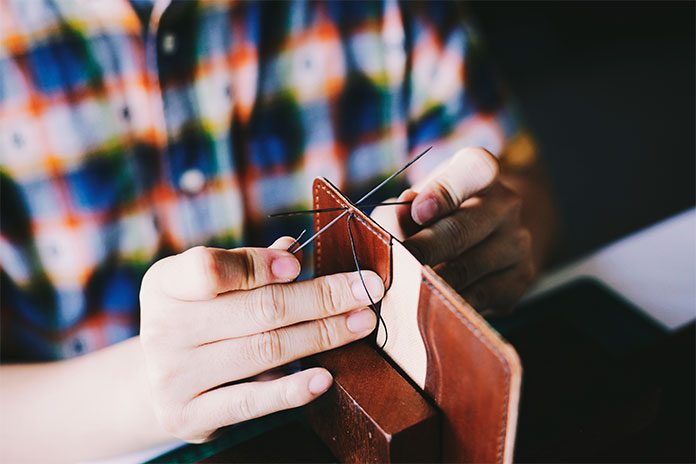You can go about sewing on patches for any creative reason. However, the most common one is that patches are required on some uniforms. If you had been a scout when you were young, then you can relate to this. The military was the first to make use of embroidered patches in the 19th century. Years ago, the patches were roughly stitched on uniforms. Some samples of these have been found, representing days gone by.
Today, people still place patches on garments for various reasons and using different methods. Sewing on patches does not even stop at the initiation. Sometimes, officers and scouts get new patches when they have been promoted.
If you need to add a patch on any garment, then you need to go through the possible methods available for you.
Possible materials you may need
This really depends on how you want to go about it. However, this should also help you decide what you should do if buying any new materials is not an option.fastwatches.co.uk,paneraireplica.uk,replica watches.
For an actual stitch, you need the following:
- A thread of the same color as the patch or the uniform
- Pair of garment scissors
- Needle
- Safety pins
- Sewing machine
- Embroidery thread
For other possible methods, you need:
- Iron
- Glue
Different ways of attaching patches on clothes
The primary method that this article is focusing on is by sewing. You may either use a needle and a thread and do it by hand. When you do this, you have to make sure that the needle is thick but not too thick. If the needle is too thick, it may destroy the fabric or even the patch itself. Others even opt to use a sewing machine, especially if the material is too thick.
Others prefer merely sticking the patch on with glue. While that method seems quick and painless, the adhesive may only hold the patch for a little while. After your clothes have gone through a tumble in the washing machine, the patch will start to peel out. Even then, you can save the patch. However, the garment that it was attached to will still have some hard to remove glue residue.
Sewing on patches on various types of materials and clothing
If you have ultimately decided on sewing on patches, this portion here will help you do so on various materials and articles of clothing.
1. Hand sewing on a regular uniform
Step One:
To ensure that your patch will get attached neatly, give your article of clothing at least one wash. Clothes often shrink after their very first wash. When you wash it before you sew on the patch, you are ensuring that you will do so on the final garment size.
Step Two:
Iron after the first wash or right before you sew on the patch. The material should be straight, not wrinkly when you sew on it.
Step Three:
Select the right needle and thread. The needle, as mentioned before, should not be too big. If you have problems finding a thread color that is the same as the clothing material or the edge of the patch, then you have to find something a little darker. The color should be close enough.
Step Four:
Position the patch where it should be. If there is a booklet guide, double-check it. It would be helpful to use safety pins to hold it in place.
Step Five:
Fit the uniform to see if the patch will be shifting the wrong way or staying in the proper place. Remember that the patch is held with safety pins. Be careful.
Step Six:
Prepare the needle and thread. Stick the thread into the eye of the needle. Hold the needle in place by tying a knot at the end of the thread.
Step Seven:
Use a straight stitch, which is the least visible kind. Continue doing so around the edges of the patch. After you are done, knot the end of the thread. Then, cut off the extra length.
2. Machine sewing the patch on clothes
Since the only difference is the use of a machine, you can follow Steps One to Five of the hand-sewn instructions. There is a little bit of twist here, though. For effective results, you should use an iron-on patch or an adhesive ironing tape. This will help you keep the path on the right spot, preventing it from wiggling about while you sew with the machine.
Steps to Follow:
Place the uniform on the machine. Thread your machine, and then set it to low speed. Then, sew around the edges.
3. Sewing a patch on a jacket
There is a particular portion for this because jackets can be tough to sew by hand. Some are easy enough to sew through with a sharp needle, but some have heavier fabrics.
Of course, you need to secure the patch in place.
- Use an iron-on patch OR use safety pins to hold the patch in place.
- Use the low-speed setting on your machine.
- If hand-sewing, protect your thumb with a thimble.
- Use a running stitch.
- If applying a running stitch on a thick and heavy jacket, you have to pull the thread all the way through no matter what side you are going.
4. Sewing a patch with a bound edge
Remember the patches from the 19th century that was mentioned earlier? They were crude and rough but had their own charm. Commercially produced patches, on the other hand, are a lot neater. The problem is that they have thick edges, which makes sewing by hand a lot tougher.
What you can do, however, is to use a whip stitch so that you go over the edge. For those planning to use a sewing machine, you can sew over up to the inner side of the patch. If your machine has a wide range, then you can probably make use of a zigzag stitch. This will match the stitches on the edges of the patch.
If you have home-made patches that you want to look more store-bought, then you can add zigzag stitches on the edges as well. You can also sew the patch in the same way as you did the commercially produced ones.
5. Sewing on quilted cotton decorative patches
Not all clothes that you attach patches to are uniforms. Some are just regular clothes that you put decorative touches to. For these types of craftwork, you have to use decorative patches made of quilted cotton.
If you are adding these decorative patches on items that will not be washed, anyway, then you can simply glue or iron them on. They should be able to hold. An example of such an item is a bag. Bags, of course, should still be washed. They can be cleaned carefully with a toothbrush and a little soap and water. There is no need to put them in the washing machine. If you have to machine-wash, you still need to apply a running or zigzag stitch on the edges. A zigzag stitch with a length of two should do the job a lot more quickly.
6. Replacing a patch
Earlier in this article, you have come to realize that the first patch you stitch in may not be the last. Whether you are or someone you know is in the police force, military, or the scouts, there are such things called promotions. Sometimes, advancements mean getting rid of the old patch to be replaced with a new one. In some cases, these involve getting more patches.
For those who are replacing a patch, these are the usual steps:
- Check the area where the old patch is.
- Use a seam ripper to detach the old patch. This is where you will best see the importance of sewing on patches, rather than gluing them on.
- With a tweezer, remove all loose threads.
- Iron the area because it would have gotten wrinkly after you have removed the old patch.
- Follow the usual steps after having ironed the area.
- As usual, you have the option to either manually or machine sew.
7. Adding decorative flair
Not all patches have to be sewn in the same way. You can also add some decorative flair or some personality.
Where will this work? Most people may think that adding flair to the stitches is a strictly girly affair. In some sense, it may be right. You can certainly imagine a little girl getting excited about getting a patch on her jeans or even her backpack. However, some styles and designs will work on boys’ clothes and bags. Both boys and girls will be thrilled to make their personalities shine through their decorative patches.
Before discussing how to add flair, when do you exactly need a little zest and style?
- To declare a certain sense of fashion
- E.g., adding patches to unexpected articles of clothing
- To highlight personality and achievements
- E.g., adding patches that show pictures that symbolize achievements and interests, like a cloth version of charm bracelets
- To distinguish the article of clothing from others like it
- E.g., adding patches to an otherwise regular pair of jeans
There can be other reasons to do it. After all, you are free to present yourself in a certain way. Make use of all your creative juices. Post the look on Instagram and get some upvotes while you are at it.
So, how do you correctly add that flair?
- Brainstorm. You may want to think about your design. Yes, it may only be a patch for some, but it will declare your personality for days or even weeks to come. It will be your battle cry if you will. Thanks to a good patch design, you may just have perked up your wardrobe. Conduct research on symbol meanings if you are not sure.
- Pick a spot to add the patch on. It should be an unusual place. If not, then make the patch itself extraordinary. You can either buy the patch from stores and make one of your own.
- Make sure that the fabric has been washed before and has been ironed (see: you are still going about it the way you would a regular uniform)
- Select your needle and thread (Here, you can veer away a little. The thread does not have to be the same color as the article of clothing or the patch. It can complement or clash: it is up to you. The thread can also be thick, like an embroidery one.
- Select the stitch type. You don’t have to be restricted to running and zigzag styles. You can choose whatever style you want that can work on your fabric.
- Deck the patch with other embellishments if you want, such as gemstones, if you like.
8. Making an embroidery patch
This section is strongly related to #7. You can make your own patches. If you want to embroider shapes onto your fabrics, do not do so straight on. You have to make patches first by decorating on fragments of cloth. Secure the edges with zigzag stitches. Then, you may add the patch onto its final place.
By doing this, you create a more unique personality rather than just buying commercially-produced patches.
A quick, alternative solution
Decorative patches often have more airtime than formal ones that you use for uniforms. Sometimes, people wearing them change their minds. So, they get replaced. If this is the case, then you may also use iron-ons for a quick, alternative solution. Gluing them on the fabric can also work out. Again, these swift, creative touches may only be applied if you are sure that the material will not get machine-washed.
So, here we are. We have gone through the reasons behind, methods of, and alternatives sewing patches on. Send us a reply to express your comments and queries.


